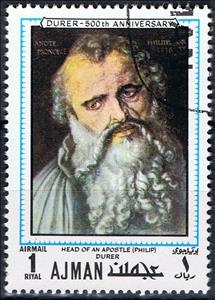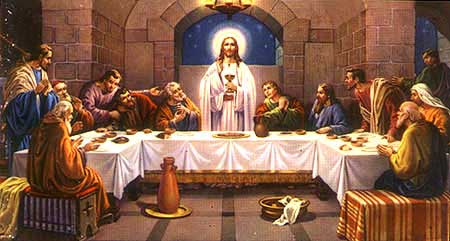Stamp: Apostle Philip (Ajman 1970)
Apostle Philip (Ajman 1970)
21 October (Ajman ) within release 500th birthday of Albrecht Dürer goes into circulation Stamp Apostle Philip face value 1 United Arab Emirates riyal
| Stamp Apostle Philip in catalogues | |
|---|---|
| Michel: | Mi:AJ 643A |
Stamp is square format.
Also in the issue 500th birthday of Albrecht Dürer:
- Stamp - Adam face value 25;
- Stamp - Self portrait at 22 face value 30;
- Stamp - Eve face value 35;
- Stamp - Suicide of Lucrezia face value 50;
- Stamp - John and Petrus face value 70;
- Stamp - Mark and Paul face value 85;
- Stamp - Apostle Philip face value 1;
- Stamp - Adoration of the Magi face value 2;
- Se-tenant - 500th birthday of Albrecht Dürer face value None;
- Stamp - Adam face value 25;
- Stamp - Adoration of the Magi face value 2;
- Stamp - Apostle Philip face value 1;
- Stamp - Eve face value 35;
- Stamp - John and Petrus face value 70;
- Stamp - Mark and Paul face value 85;
- Stamp - Self portrait at 22 face value 30;
- Stamp - Suicide of Lucrezia face value 50;
- Se-tenant - Aj 637b-644b face value 5.95;
- Full Pane - 500th birthday of Albrecht Dürer face value 4*5.95;
- Full Pane - Aj 637b-644b face value 4*5.95;
Stamp Apostle Philip it reflects the thematic directions:
An apostle (/əˈpɒsəl/), in its literal sense, is an emissary. The word is derived from Ancient Greek ἀπόστολος (apóstolos), literally "one who is sent off", itself derived from the verb ἀποστέλλειν (apostéllein), "to send off". The purpose of such sending off is usually to convey a message, and thus "messenger" is a common alternative translation; other common translations include "ambassador" and "envoy". The term in Ancient Greek also has other related meanings
Painting is the practice of applying paint, pigment, color or other medium to a solid surface (support base). The medium is commonly applied to the base with a brush, but other implements, such as knives, sponges, and airbrushes, can be used. Painting is a mode of creative expression, and the forms are numerous. Drawing, gesture (as in gestural painting), composition, narration (as in narrative art), or abstraction (as in abstract art), among other aesthetic modes, may serve to manifest the expressive and conceptual intention of the practitioner. Paintings can be naturalistic and representational (as in a still life or landscape painting), photographic, abstract, narrative, symbolistic (as in Symbolist art), emotive (as in Expressionism), or political in nature (as in Artivism). A portion of the history of painting in both Eastern and Western art is dominated by spiritual motifs and ideas. Examples of this kind of painting range from artwork depicting mythological figures on pottery, to Biblical scenes rendered on the interior walls and ceiling of the Sistine Chapel, to scenes from the life of Buddha or other images of Eastern religious origin. In art, the term painting describes both the act and the result of the action. The support for paintings includes such surfaces as walls, paper, canvas, wood, glass, lacquer, clay, leaf, copper and concrete, and the painting may incorporate multiple other materials including sand, clay, paper, plaster, gold leaf, as well as objects. The term painting is also used outside of art as a common trade among craftsmen and builders.


